Exchange-traded funds, or ETFs, are popular in the United States. They offer diversification and flexibility to investors. The question of whether ETFs increase volatility is a topic of interest.
Etfs volatility is a concern because it can affect the market’s stability. In this article, we will look at the relationship between ETFs and market volatility. We will also examine the factors that contribute to etfs volatility and their impact on the market.
Key Takeaways
- Etfs volatility is a concern for investors and financial experts.
- Do etfs increase volatility is a topic of ongoing debate.
- Understanding the relationship between ETFs and market volatility is crucial for investors.
- Etfs volatility can impact the overall stability of the market.
- ETFs offer diversification and flexibility to investors in the United States.
- The rise of ETF trading volume has contributed to the discussion around etfs volatility.
Understanding the Relationship Between ETFs and Market Volatility
Exchange-traded funds (ETFs) are popular for their diversification and flexibility. But, their effect on market volatility is a hot topic among financial experts. To grasp this, we need to know what market volatility is and look at ETF trading history.
Market volatility is the uncertainty or change in a security or market index value. Etfs impact on market volatility is key, as their trading can shape the market. The rise in ETF trading volume is notable, with many investors looking to benefit from exchange-traded funds and volatility.
To understand ETFs and market volatility, let’s look at market patterns before and after ETFs became popular. Important points include:
- Increased trading activity: ETF trading volume growth has boosted market activity, which can lead to volatility.
- Improved market efficiency: ETFs can make markets more efficient by facilitating arbitrage, which helps stabilize prices.
- Changing investor behavior: ETFs have changed how investors act, with some focusing on short-term gains, which can increase volatility.
By looking at these factors and the history of ETF trading, we can see how ETFs and market volatility are connected. This includes the etfs impact on market volatility and how exchange-traded funds and volatility influence market trends.
Do ETFs Increase Volatility? Examining the Evidence
Understanding the link between volatility and etfs performance is key. Studies have looked into this, offering insights. For example, some research shows that etfs volatility analysis can spot market trends, aiding investors.
ETFs track their underlying indices well. But, during high volatility times, they can see big price swings. This affects their performance. Yet, some ETFs aim to reduce volatility through diversification or hedging.

Research on ETFs and volatility has been done. It uses stats and simulations to study ETFs’ impact on markets. The results are mixed but offer valuable info for investors.
Some key findings are:
- ETFs can increase volatility in some market situations
- Etfs volatility analysis can reveal risks and chances
- ETFs can help manage volatility and meet investment goals
By looking at the evidence, investors can make better choices. As the ETF market grows, keeping up with new research in etfs volatility analysis is crucial.
The Mechanics Behind ETF Trading and Price Movements
ETF trading has grown a lot in the financial markets. It’s interesting to see how it affects market volatility. The etfs effects on market volatility come from how ETFs are created and redeemed.
Authorized participants can swap a basket of securities for ETF shares. This can change the prices of the securities inside the ETF.
ETF trading also offers arbitrage chances. These chances help keep the market efficient. If an ETF’s price doesn’t match its net asset value, arbitrageurs can make money. They buy or sell the ETF and the securities it holds, making prices even out.
But, this process can also raise etfs volatility risk if not handled well.
Some important things to think about in ETF trading include:
- Creation and redemption process: This lets participants swap a basket of securities for ETF shares.
- Arbitrage opportunities: These help keep the market efficient by making prices match the net asset value.
- Impact on underlying securities: The creation and redemption process can affect the prices of the securities inside the ETF.

In summary, knowing how ETF trading works is key to understanding its impact on market volatility and risk. By looking at the creation and redemption process, arbitrage, and how it affects securities, investors can see ETFs’ role in the markets.
Conclusion: Balancing ETF Benefits and Market Impact
The ETF market is growing fast. It’s important to look closely at how these investments affect market volatility. ETFs give investors diversification and flexibility, but some worry they might make markets more unstable.
The effect of ETFs on market swings is not simple. Things like how much they’re traded, how they’re balanced, and what they hold matter a lot. As ETFs become more common, we need more research to know how they really work. This will help make sure they help investors, not hurt the market.
We must weigh the good things about ETFs, like easy access to different investments and low costs, against any possible downsides. By keeping an eye on how ETFs and market volatility interact, we can use these tools wisely. This way, we can make sure they help the market, not harm it.

